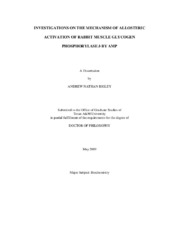| dc.contributor.advisor | Reinhart, Gregory D. | |
| dc.creator | Bigley, Andrew N. | |
| dc.date.accessioned | 2010-07-15T00:12:10Z | |
| dc.date.accessioned | 2010-07-23T21:43:42Z | |
| dc.date.available | 2010-07-15T00:12:10Z | |
| dc.date.available | 2010-07-23T21:43:42Z | |
| dc.date.created | 2009-05 | |
| dc.date.issued | 2010-07-14 | |
| dc.date.submitted | May 2009 | |
| dc.identifier.uri | https://hdl.handle.net/1969.1/ETD-TAMU-2009-05-483 | |
| dc.description.abstract | Much work has been carried out on glycogen phosphorylase over the last seventy years. Interest has persisted due not only to the usefulness of phosphorylase as a model system of allostery, but also due to the connection to the disease state in type II diabetes. The bulk of research consists of structural studies utilizing the wild-type enzyme from rabbit muscle. In this study we have employed linkage analysis in combination with structural perturbations via site-directed mutagenesis to test kinetic models of activation of phosphorylase b by AMP, and to examine the roles of the N-terminus, the acidic patch, ?-helix 1 and the 280?s loop in activation by AMP. Experiments have been carried out on purified glycogen phosphorylase b variants to determine the effects of perturbations in vitro. The kinetic models of activation by AMP are found to be a relatively accurate description of kinetic behavior of wild-type phosphorylase b, but are found to be technically incorrect with respect to the absolute requirements of two equivalents of AMP to be bound prior to catalysis. Phosphorylase b demonstrates activity in the absence of AMP, though only at high concentrations of phosphate, and a hybrid phosphorylase b with only a single functional AMP binding sight shows slight activation. The truncate ?2-17 shows weakened binding to AMP and phosphate in the apo enzyme, but maintains activation by AMP to an affinity similar to that of wild-type, indicating that the N-terminus is not required for activation by AMP, but has a role in establishing the affinity for both AMP and phosphate in the apo enzyme. Perturbations of the acidic patch indicate that interactions between the acidic patch and the N-terminus enhance the affinities in the apo enzyme, suggesting that the structures of the N-terminus at the acidic patch may represent an active form of the enzyme. ?-helix 1 is found to have a role in homotropic cooperativity in phosphorylase b, but not in heterotropic activation by AMP, while the 280?s loop is confirmed to have a role in the heterotropic coupling between AMP and phosphate. Based on the findings in this study an alternate structural model of activation by AMP involving ?-helix 8 is proposed. | en |
| dc.format.mimetype | application/pdf | |
| dc.language.iso | eng | |
| dc.subject | Allostery, Regulation, Glycogen Phosphorylase, AMP | en |
| dc.title | Investigations on the Mechanism of Allosteric Activtion of Rabbit Muscle Glycogen Phosphorylase b by AMP | en |
| dc.type | Book | en |
| dc.type | Thesis | en |
| thesis.degree.department | Biochemistry and Biophysics | en |
| thesis.degree.discipline | Biochemistry | en |
| thesis.degree.grantor | Texas A&M University | en |
| thesis.degree.name | Doctor of Philosophy | en |
| thesis.degree.level | Doctoral | en |
| dc.contributor.committeeMember | Raushel, Frank | |
| dc.contributor.committeeMember | Pettigrew, Donald W. | |
| dc.contributor.committeeMember | Bryk, Mary | |
| dc.type.genre | Electronic Dissertation | en |
| dc.type.material | text | en |


